Reports
advertisement
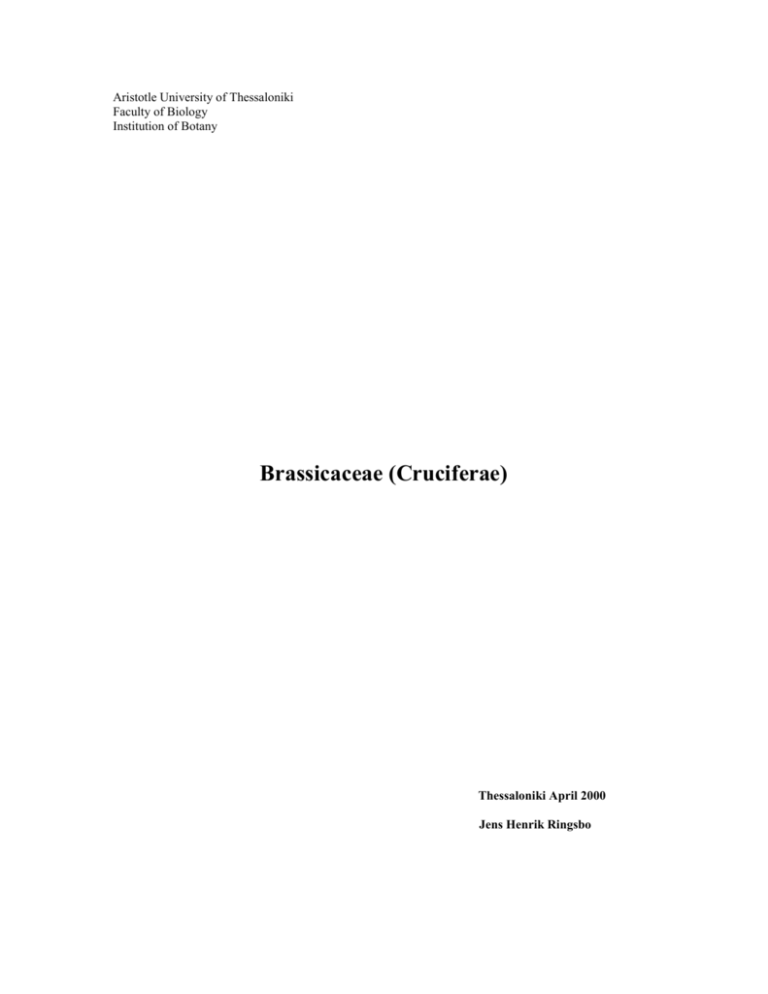
Aristotle University of Thessaloniki Faculty of Biology Institution of Botany Brassicaceae (Cruciferae) Thessaloniki April 2000 Jens Henrik Ringsbo 1. Taxonomy Division: Class: Subclass: Order: Family: Magnoliophyta Magnoliatae Dilleniidae Capparales Brassicaceae 2. Description There are 350 genera and about 3000 species of Brassicaceae or Cruciferae that they also are called. A more used name is mustard family. This regards to that many of the plants are the vegetables that we enjoy for dinner. Among them are cabbage, cauliflower, broccoli and radishes. Their floral formula are: K4C4A4+2G(2) Habitat: They can be found almost everywhere, like on fields, courtyards, roadsides,… and they are common in most of the countries of the world. But they are for sure more famous as cultivated species in our gardens. Leaves: The leaves of Brassicaceae are alternate or rarely opposite and typically. They are usually spiraled but some can be distichous. Picture: The leaves of Brassicaceae http://www.agron.iastate.edu/~Weeds/Ag317/ID/wmust.html They are quit simply but have sometimes deeply parted segments. They lack stipules. The size varies from minute to very large Inflorescence: Flowers aggregated in ‘inflorescences’ (usually), or solitary (rarely); in corymbs (commonly), or in racemes, or in spikes, or in fascicles. Inflorescences terminal, or axillary, or leaf-opposed. Flowers: Flowers regular, under sitting and consist of 4 sepals and 4 petals. The color of the petals varies. They can be white, yellow, orange, purple or blue. Picture: Look at the petals http://www.agron.iastate.edu/~weeds/Ag317/ID/wmust.html The flowers are bisexual and almost always actinomorphic. They have,usually, 6 stamens – 4 long and 2 shorter. Carpels are 2. Fruit: Fruit a silicula to a siliqua. Picture:Silicula and siliqua http://www.agron.iastate.edu/~weeds/Ag317/ID/wmust.html 3. Geography Frigid zone to tropical. Cosmopolitan, concentrated in the North temperate and Mediterranean. 4. Representative genera and species While the family consists of 350 genera and 3000 species it is of no meaning to put them here all. Therefore will just some of them be presented, but with a lot of characteristics. Raphanus sativus, wild radish. The cross-shaped configuration of the flowers in this family resulted in its early designation as the Cruciferae. The style with its small capitate stigma can be seen just above the anthers. Their fruits are called siliques when they look like they do in the picture. The condition of four long and two short stamens is described as tetradynamous, and is typhical for the family. On the base of each petal can a greenish claw be seen. (See picture on next side) Picture: Raphanus sativus (Gerald D. Carr) http://www.wisc.edu/botit/img/bot/401/ Capsella bursa-pastoris, shepherds purse. Usual at open, fairly nutrient rich grounds. Fields, gardens, roadsides, courtyards and pasturelands. Annual. Bare. Rosette leaves usually lobed, dark green. Stem leaves whole with arrow like base. Petals 2mm, white. Siliques and silicles very characteristic 3 angular. At maturity the two valves of siliques and silicles separate from the persistent replum or false partition. A few seed stalks or funiculi can still be seen attached to the edge of some of the persistent partitions. Brassica nigra. 40-100 cm. Can be found in harbours, flower beds and at no used fields. Before cultivated. Lower leaves with few lobes and a big end lobe. Stem leaves stalked, oblong and whole. Petals 7-9mm, yellow with dark veins. Silicle 1-2cm and 4 angular on long stalks. (See picture on next side) Picture: Brassica nigra http://www.euronet.nl/users/mbleeker/folis/bsmain-e.html Typical cultivated Brassicaceae Picture: Brassica Hirta http://www.wisc.edu/botit/img/bot/401/ Picture: Brassica oleracsea var acephala (Brussells sprouts) Picture: Brassica oleracsea var acephala (Cabbage) http://www.wisc.edu/botit/img/bot/401/ 5. Uses (economically important species) Important food crops from Brassica (cabbage, cauliflower, broccoli, kohlrabi, turnips,Brussels sprouts); Raphanus (radish); Rorippa (watercress); condiments from Brassica (mustard), Armoracia (horse-radish); ornamentals from about 50 genera, e.g. Arabis, Erysimum (Cheiranthus), Hesperis, Iberis, Lobularia, Lunaria, Matthiola. (http://biodiversity.uno.edu/delta/angio/www/crucifer.htm) 6. Other: History, poems etc During the centuries has the name of Brassicaceae of course, like all other families changed name several times. The old names are not to be forgotten while they are of great important when to study the history of the plants. Here will therefore follow those names that have been accepted as synonyms. Some poems can also be found about the family, and two of them are added further down. Brassicaceae Burnett, Outl. Bot.: 854, 1093, 1123. Jun 1835, nom. cons. Cruciferae Juss., Gen. Pl.: 237. 4 Aug 1789, nom. cons. et nom. alt. Drabaceae Martinov, Tekhno-Bot. Slovar: 215. 1820. Erysimaceae Martinov, Tekhno-Bot. Slovar: 238. 1820. Raphanaceae Horan., Char. Ess. Fam.: 169. 1847. Schizopetalaceae A. Juss. in C.V.D. d'Orbigny, Dict. Univ. Hist. Nat. 11: 419. 9 Sep 1848. Sismbriaceae Martinov, Tekhno-Bot. Slovar: 583. 1820. Stanleyaceae Nutt., J. Acad. Nat. Sci. Philadelphia 7: 85. 1834. Thlaspiaceae Adans., Fam. Pl. 2: 421. Jul-Aug 1763. (http://botany.about.com/education/botany/gi/dynamic/offsite.htm) And white and purple jiliflowers that stay Lingering in blossom summer half away And single blood walls of a luscious smell Old fashioned flowers which huswives love so well (John Clare 1827, ‘The Shepherd’s Calendar, June’ — Matthiola and Cheiranthus) In the season of the tulip cup, When blossoms clothe the trees, ’Tis sweet to throw the lattice up And scent thee on the breeze (Moir, quoted by Ann Pratt, ‘Wild Flowers’ (1857) - of Wallflowers) 7. Literature used http://ag.arizona.edu/classes/rnr202/taxtour/menu.html http://biodiversity.uno.edu/delta/angio/www/crucifer.htm http://www.botany.hawaii.edu/faculty/carr/brassic.htm http://www.plants.montara.com/Listpages/FamPages/Brassica2.html http://botany.about.com/education/botany/gi/dynamic/offsite.htm http://www.wisc.edu/botit/img/bot/401/ http://www.euronet.nl/users/mbleeker/folis/bsmain-e.html Mossberg B, Stenberg, Ericsson – DEN NORDISKA FLORAN, 1997, W&W
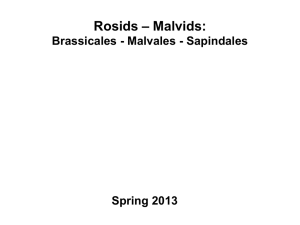
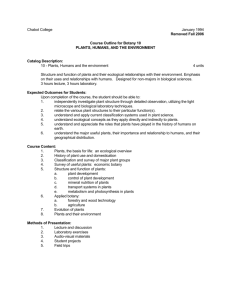
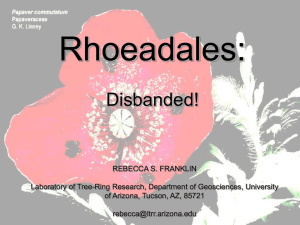
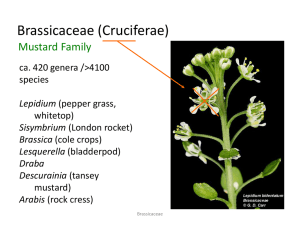
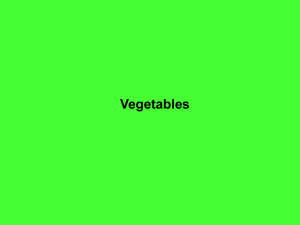
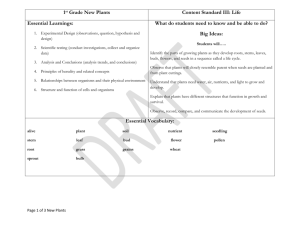

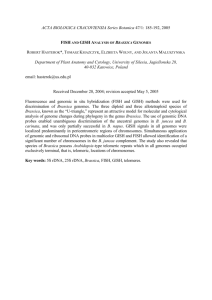
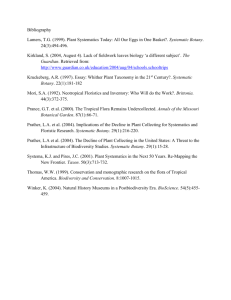
![[[1]] Kew March 29th 1857 Dear Asa Gray Thanks for your note of](http://s3.studylib.net/store/data/008559036_1-c38096c18b81e3e943f471c38e24cd22-300x300.png)